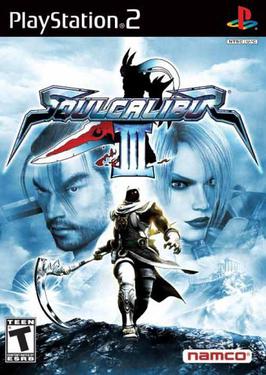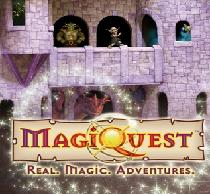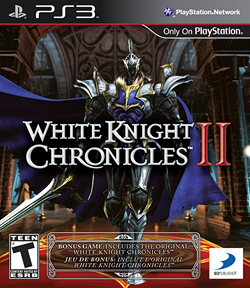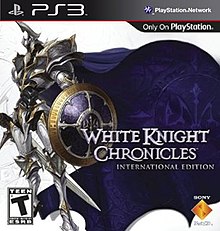
Vagrant Story is an action role-playing game developed and published by Square for the PlayStation video game console. The game was released in 2000 and has been re-released by Square Enix through the PlayStation Network for the PlayStation 3, PlayStation Portable and PlayStation Vita consoles. Vagrant Story was primarily developed by the team responsible for Final Fantasy Tactics, with Yasumi Matsuno serving as producer, writer and director.

Dark Chronicle, released as Dark Cloud 2 in North America, is a 2002 action role-playing game developed by Level-5 and published by Sony Computer Entertainment for the PlayStation 2 (PS2). It was released in Japan before releasing in English in 2003. An emulated version of the game was released for the PlayStation 4 through the PlayStation Network in 2016.

SaGa Frontier is a 1997 role-playing video game developed by Square for the PlayStation. The game was published by Sony Computer Entertainment (SCEA) in North America on March 25, 1998. It is the seventh game in the SaGa series, and the first to be released on the PlayStation. It is also the first in the series to be released under the SaGa brand outside Japan; previous overseas releases had used the Final Fantasy brand instead. A remastered version featuring additional characters, events and features was released on April 15, 2021 for Android, iOS, Nintendo Switch, PlayStation 4 and Windows.

Soulcalibur III is a fighting video game produced by Namco as a sequel to Soulcalibur II and the fourth installment in the Soulcalibur series. It was originally released for the PlayStation 2 in 2005. An improved arcade version, Soulcalibur III: Arcade Edition, was released in 2006. It was the last Soulcalibur game to receive an arcade version, as IV onwards did not have an arcade release, and was also the last to be released by Namco as an independent company, as it would merge with Bandai's video game division to form Bandai Namco Entertainment in 2006. It is the second in the Soulcalibur series’ 1590 A.D. trilogy games, between II and IV.

The Legend of Dragoon is a role-playing video game developed by Japan Studio and published by Sony Computer Entertainment for the PlayStation in 1999 in Japan, 2000 in North America, and 2001 in Europe. Set in a high fantasy fictional world called Endiness, the game follows a group of warriors led by the protagonist, Dart, as they attempt to stop the destruction of the world. The player controls a party of 3D character models through pre-rendered, linear environments. Combat uses a combination of turn-based mechanics and real-time commands. Notably, the game includes a quick time event called "addition" during each attack, requiring the player to press a button when two squares converge.

Level-5 Inc. is a Japanese video game developer and publisher based in Fukuoka. The company was founded in October 1998 by Akihiro Hino after he departed from Riverhillsoft. Early in its history, the company enjoyed a close relationship with Sony Computer Entertainment, with many of its games then funded by and produced in conjunction with them. Level-5 began self-publishing its games in Japan by the late 2000s, with other companies such as Nintendo handling publishing worldwide. The company is best known for their Dark Cloud, Professor Layton, Inazuma Eleven, Ni no Kuni, Yo-kai Watch, and Snack World franchises.

Dungeons & Dragons: Shadow over Mystara is an arcade game developed and published by Capcom in 1996 as a sequel to Dungeons & Dragons: Tower of Doom. The game is set in the Dungeons & Dragons campaign setting of Mystara.

Tomba! 2: The Evil Swine Return, or simply Tomba! 2, is a platform-adventure game developed by Whoopee Camp and published by Sony Computer Entertainment for the PlayStation. The game was released in Japan in 1999 and in other territories the following year. The game is a sequel to Tomba! and centers on the exploits of the eponymous feral child as he attempts to rescue his friend Tabby from an evil race of anthropomorphic pigs.

Ape Escape is a series of video games developed primarily by Japan Studio and published by Sony Computer Entertainment, starting with Ape Escape for PlayStation in 1999. The series incorporates ape-related humour, unique gameplay, and a wide variety of pop culture references. The first game in the series is the first game to have made the DualShock or Dual Analog controller mandatory.

Knights of the Round is an arcade game released by Capcom in 1991. A side-scrolling beat 'em up based loosely on the legend of King Arthur and the Knights of the Round Table, the game features an action role-playing video game-like level advancement system, with fighters automatically being upgraded to new weapons and armor as they advance through the game. In September 13, 2018, Capcom announced Capcom Beat 'Em Up Bundle with the arcade edition of Knights of the Round being one of seven titles and being released digitally for Nintendo Switch, PlayStation 4, Xbox One, and Windows on September 18, 2018.

Dark Cloud is an action role-playing video game developed by Level-5 and published by Sony Computer Entertainment for the PlayStation 2. Originally intended as a launch title for the system in March 2000, the game was eventually released in Japan in December 2000, in North America in May 2001, and in Europe in September. A spiritual sequel, Dark Chronicle, was released in Japan in 2002 and worldwide the following year.

MagiQuest is a live action role-playing game where players take the role of magic users. The game takes place in dedicated MagiQuest locations in which players, known as Magi, use an infrared (IR) emitting wand to interact with objects.

Final Fantasy VII is an unlicensed "Shanzhai" demake of SquareSoft's role-playing video game Final Fantasy VII, originally released for PlayStation in 1997. The two-dimensional "port" was developed and published by Chinese company Shenzhen Nanjing Technology for Subor, a Famiclone. The cartridge itself is unique, as it is structurally different from licensed Famicom cartridges in terms of hardware and programming.

Ghosts 'n Goblins, known in Japan as Makaimura, is a run-and-gun platform video game series created by Tokuro Fujiwara and developed by Capcom. The first entry in the series was Ghosts 'n Goblins, released in arcades on July 7, 1985. The series has subsequently been ported to and released on a variety of personal computers, game consoles and mobile platforms and spawned several sequels and spin-offs.

White Knight Chronicles II is a video game developed by Level-5 and published by Sony Computer Entertainment in Japan and Europe and by D3 Publisher in North America for the PlayStation 3. The game is a direct sequel to White Knight Chronicles (2008). The game was released in Japan on July 8, 2010, in PAL regions in June 2011, and in North America on September 13.

White Knight Chronicles: Origins is a role-playing video game developed by Japan Studio, and published by Sony Computer Entertainment exclusively for the PlayStation Portable. The game is a prequel to the 2008 title White Knight Chronicles and was released on February 3, 2011 in Japan. In Europe, the game was released on June 8 in most European countries, June 9 for Australia and New Zealand and June 10 for UK and Ireland, with no plans for a North American release.

Young Thor is an American-Canadian action-adventure video game developed by Frima Studios and published by Sony Computer Entertainment. Like Zombie Tycoon, it is produced with the participation of Telefilm Canada. It was first released in 2010 as a downloadable PlayStation Network title for the PlayStation Portable and PlayStation 3. Young Thor is about the childhood of the eponymous Norse god, Thor, as he embarks on a quest to save the world tree, Yggdrasil. The game was met with mixed or average reviews from critics upon release.

Oreshika: Tainted Bloodlines is a 2014 Japanese role playing game developed by Alfa System and published by Sony Computer Entertainment for the PlayStation Vita. Oreshika is the sequel to the 1999 PlayStation game Ore no Shikabane o Koete Yuke, which received a remake in 2011 for the PlayStation Portable.

To Heart 2: Dungeon Travelers is a role-playing video game developed by Sting and published by Aquaplus on June 30, 2011 for the PlayStation Portable in Japan only, and on 15 Feb 2024 for PC via Steam. The game is a spin-off from Leaf's To Heart 2 franchise, and gameplay highly resembles another To Heart 2 based mini game from the Windows visual novel Manaka de Ikuno!!, titled Final Dragon Chronicle: Guilty Requiem.

Kileak: The DNA Imperative, known as Kileak: The Blood in Japan and Europe, is a first-person shooter video game developed by Genki for the PlayStation. It was published in Japan by Sony Music Entertainment in January 1995, followed by a North American and European release in September 1995 by Sony Computer Entertainment as a launch game for the console. Kimitaka Matsumae, former member of the S.S.T. Band, wrote the game's soundtrack.




















